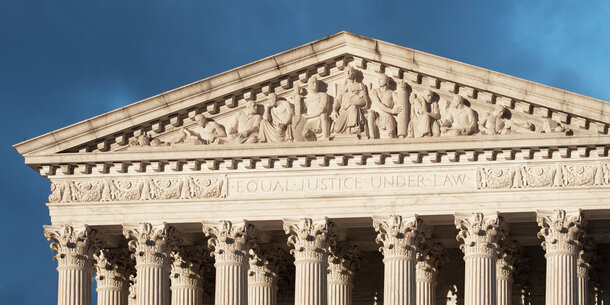You’re reading The Briefing, Michael Waldman’s weekly newsletter. Click here to receive it every week in your inbox.
Constitution watchers brace for upcoming Supreme Court rulings on the Voting Rights Act, affirmative action, and the “independent state legislature theory.” The Marble Palace on First Street gets most of the attention. In the meantime, federal judges across the country are showing us what happens when the lower courts are stuffed with right-wing ideologues.
After a hearing last week, Judge Matthew Kacsmaryk in Amarillo, Texas, is expected to soon rule on an outlandish demand to ban the use of the abortion pill mifepristone — medication used for more than half of all abortions in the United States. If the judge rules to revoke the decades-old FDA approval for the pill, he will affect not just women in Texas, but women in every state.
How can a single federal judge have such power over the medical decisions of more than 167 million people? Believe it or not, the Supreme Court has never ruled on whether nationwide injunctions are constitutional. Liberals used this tactic on occasion to block the Trump administration’s policies, such as the single judge who blocked the “Muslim ban” in 2017. But conservatives have undeniably perfected it.
In Texas, a quirk of the rules lets people choose where they bring a federal lawsuit and essentially handpick the judge who will hear their case — judge shopping to boost the chances of a favorable ruling. When a plaintiff files a federal suit in Amarillo, they are 100 percent guaranteed to get Kacsmaryk, a judge with a reputation as a Federalist Society militant. His sister recently told reporters it was his mission to end abortion in the United States. He has called homosexuality “disordered.” He made the government reinstate the Trump-era “Remain in Mexico” policy, which was later overturned by the Supreme Court. Such a track record would make him the ideal judge for anti-abortion groups seeking someone sympathetic to their case.
Worse, Kacsmaryk may be readying his abortion pill ruling based on the brand-new “major questions doctrine,” which is all of nine months old. First articulated in a case last year that slashed the Environmental Protection Agency’s regulatory power, the doctrine claims federal agencies need clear congressional authorization to act on issues that have “major” economic or political significance. This conveniently flexible legal theory is poised to be the go-to reasoning for right-wing judges to block any policies they don’t like.
The Texas case isn’t the only evidence of the impact of skewed lower courts. The Supreme Court’s sweeping decision in New York State Rifle and Pistol Association v. Bruen, which held that gun laws must pass the test of “history and tradition” rather than public safety, has led to judicial rulings that verge on satirical. One federal judge in western New York blocked most of the state’s new gun law, declaring he could find no colonial-era law banning guns in summer camps, which, of course, did not exist at the time. And surprise, surprise, he found no trace of 18th-century prohibitions on guns in subways, either. Though he let the ban on guns in churches stand, another New York judge ruled shortly afterward that this restriction, too, was ahistorical.
Just last month, the U.S. Court of Appeals for the Fifth Circuit issued a truly outrageous ruling that upheld domestic abusers’ right to keep their guns. The court cited a lack of examples in early American laws against domestic violence. Voila, no protections in 2023.
Other examples abound, and there will no doubt be many more to come. Trump isn’t only responsible for appointing three Supreme Court justices — he appointed 226 federal judges during his presidency. They were overwhelmingly pre-vetted by the Federalist Society.
These appointments have left a lasting impact, and there is an urgent need to rebalance the scales of the federal judiciary. Last week, the Judicial Conference of the United States, led by Chief Justice John Roberts, recommended adding 68 federal judges to the courts to meet demanding new workloads. This would be a good step toward countering the partisanship plaguing the courts. But most importantly, we need to understand the significance of what has happened with the federal courts.
We cannot let one judge with a gavel and a grudge govern our country.



